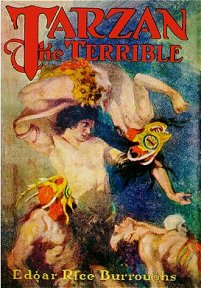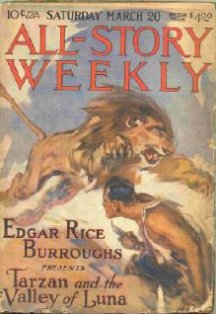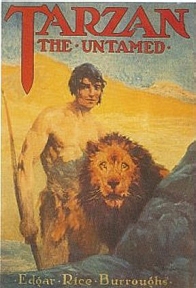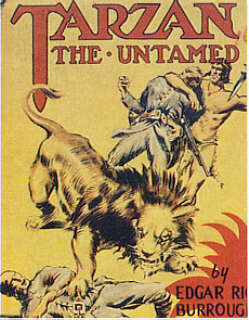Edgar Rice Burroughs seems to be searching for his sexual identity
in Tarzan The Untamed. The untamed may refer to the notion that
he may be married but Emma has not domesticated the roaring Lion Man.
On my first reading of the novel I merely picked up the surface story,
that, to tell the truth, I don’t find very interesting perhaps even implausible
and ridiculous. On the second and third readings however the story behind
the story, ERB’s psychological dilemma begins to emerge coloring the story
with interest.
The story even begins to assume a certain beauty, a poetic shimmer,
that takes form as you stare into it. I began to relate Untamed to other
novels and stories, that seemed to me to be related and partake of the
same dilemma. I don’t know that I can successfully relate them to Untamed
but I’ll give it a shot.
For the last few years shifting around in the back of my mind have been
the tales of E.T.A. Hoffman. Just a moment ago as I write this I finished
another tale of the German romantics, a charming story that I recommend
highly, Undine, by Friedrich de la Motte-Fouque. And finally although this
may be difficult to see Fyodor Dostoievsky’s Crime and Punishment.
Untamed begins with the murder of Jane, Burroughs aspect of female sexuality,
and Tarzan’s killing of the panther or his emasculated sexuality that manifests
itself as a homosexual latency.
One then is led to believe that by killing sexual desire Tarzan or ERB
believes that he has eliminated the troubling sexual ambivalence of his
character. Yet, just a few pages on they flicker to life again in the character
of the putative German spy Bertha Kircher. Tarzan first sees Kircher as
a woman in the German camp so grasping at the obvious he assumes that she
is a German spy. He doesn’t realize and we won’t be told until the end
of the story that she is a double agent. In reality she is an English spy
posing as a German spy. There’s a complexity there that eludes me at the
moment.
She is thus introduced to Tarzan as a woman. The next time he sees her
is as a man disguised as a British agent in the English camp. He doesn’t
recognize her although he know he has seen him somewhere before. Thus the
old sexual ambivalence resurfaces. In what seems to be your standard adventure
story delicate psychological nuances begin to flicker around the action
story like St. Elmo’s Fire. No matter what the surface story is about the
secondary story is about something else.
La Motte Fouque in his Undine also addresses the problem of a man faced
with a sexual dilemma that lies within. The path is clear for the hero,
Huldbrand, it is only his own weakness that creates the problem for him.
In Huldbrand’s case his decision is between two women amidst elemental
forces of nature that contrast with the elemental human nature. Undine
is a story of astonishing beauty that I can only slaughter in interpreting
. I highly recommend you read it. For those deeply into fantasy you will
find Undine as fantastic as anything you have ever read; for those into
myth and fairytale it is a masterpiece of the kind. Anyone who reads around
in this area will have heard it mentioned. I have known of the title for
many years but recently in my researches into H.G. Wells it was mentioned
that Undine was a favorite of his. I thought it necessary background so
I added this gorgeous story to my memory stacks. I should have waited so
long; it is a superb Anima-Animus story.
In the December 14th
ERBzine 2002 George McWhorter provided a list of a few post-WWII books
that ERB read. As ERB titles the list, a few of the books he has read,
and the list is astonishingly long from a few one can only guess that ERB’s
full list must have a couple hundred or more. As reading was a lifelong
habit for him and if he consumed titles at that voracious pace then it
is truly difficult to guess how many books he read from, say, 1888 to 1910
just before he began writing. Of course his potential list to select from
before 1910 was much shorter than ours is today. Titles as obscure today
as Undine were relatively well known then. I may be wrong but I pick up
hints of Crime and Punishment in ERB’s corpus from time to time. Certainly
by his WWII list he had crime on his mind.
We do know that the stories that disappeared into his capacious mind
from the period before 1910 gestated for decades in the back of his mind
finally finding expression thirty or forty years later. I’m thinking of
George W.M. Reynold’s Mysteries Of The Court Of London that burst
forth in the 1938 version of The Lad And The Lion. So while I can’t
say for certain that ERB read these three authors there is a certain wistfulness
and fairy tale quality to the story of Tarzan, Bertha Kircher and Harold
Percy Smith-Oldwick that reminds one of the three authors that I have mixed
up with Untamed.
So, a woman named Bertalda sends the knight Huldbrand into the elemental
forest to prove his love for her. Thus Huldbrand goes to a destiny he never
imagined. In the sense of C.G. Jung’s collective unconscious which as I
interpret as a set of symbols common to the Western mind, Burroughs also
sends Tarzan and his two sexual identities into the elemental jungles of
Africa.
La Motte-Fouque invents the water spirit Kuhleborn to forward the action.
The presence of so much water indicates that the action takes place in
the subconscious of Huldbrand.
Water plays a very different role in Burroughs’ story. In his tale Tarzan
braves a watered land to traverse eight very deep and steep ravines that
become progressively drier until in the last he almost dies of thirst.
As Burroughs’ story covers the four years in his life from late 1914 until
mid-1919 one may assume that he had eight bouts of progressively severe
depression the eighth and last occurring as he writes his story.
On the other side of the last canyon the well watered jungle begins
again. Thus the main story of Tarzan, Bertha and Smith-Oldwick takes place
on the edges of the forest and a meadow.
In La Motte-Fouque’s story the elements had set up the conflict from
the beginning. As we are told Kuhleborn stole the baby Bertalda away from
her parents in an apparent drowning. He then restored a child to
the bereaved parents with the child Undine who was actually a water sprite.
Bertalda was left by the side of the road where a noble couple found and
adopted her. She is the lost daughter of the now aged couple of Undine’s
adoptive parents to which Kuhleborn now leads Huldbrand.
Undine’s parents live on an isolated peninsula. As soon as the storm
drives Huldbrand to the peninsula the elemental Kuhleborn in the form of
a raging torrent turns the peninsula into an island from which there is
no escaping. Huldbrand and Undine are thus thrown together. Elemental spirits
have no souls. This notion would certainly have had great appeal for Burroughs
for whom men without souls was a preoccupation. Undine can only acquire
a soul, which she greatly longs for, from the love of a man who has one.
She therefore in effect seduces Huldbrand. Kuhleborn disapproves but as
to a point Undine’s magic is stronger than his he is reluctantly forced
to accede on certain conditions.
A wandering priest is tossed up on shore by Kuhleborn who ties the knot
for Undine and Huldbrand. They return to civilization and Berthalda where
the conflict between a human woman with a soul and a water sprite without
one puts Huldbrand to the test.
So Tarzan who is first associated with Bertha Kircher is once again
presented with his emasculation conflict when Smith-Oldwick appears in
the picture. The name Smith occurs in Burroughs’ work with some frequency
while Old-wick may have sexual connotations unless I’m being too Freudian.
Before Smith-Oldwick does appear Tarzan has to cross the continent from
East to West. His wish is to return to his father’s cabin, build an addition
or two to make it more roomy and comfortable then settle in as a sort of
gentleman farmer. Ah, to be so world weary. And yet that is what
Burroughs is about to do.
In a rather remarkable episode Tarzan is crossing Africa when he comes
upon Bertha Kircher out there somewhere. He takes her captive but for some
unknown reason doesn’t relieve her of the pistol at her side. Even stranger
he walks along in front of his captive. Bertha not slow to grasp an opportunity
reaches up and lays the butt of her pistol alongside the back of the Big
Fella’s head. There’s one bash in the head so far.
Bertha takes off for the railroad leaving Tarzan lying face down in
the trail. As he lies Sheeta the panther comes upon him. This presents
a sexual problem difficult of analysis. Does it mean that Tarzan is unaware
of his attraction to Bertha or what? Tarzan is all but dead as Sheeta prepares
to spring on him when who should appear but the Lion whose will Tarzan
broke earlier in the story. Now totally devoted to his oppressor he kills
Sheeta. Tarzan regains consciousness to find himself nose to nose with
Numa. Reminds you of that horrid joke Hillman told a while back about the
elephant. In this case it was the same lion.
So the Lion and Tarzan are united in spirit. Tarzan is not yet known
as the Lion Man but he will be. In any event the Lion is a guardian spirit
for him. In the second book after this one, perhaps reflecting this lion
Tarzan will raise and tame the Golden Lion who will be his helpmate and
guardian angel. I suspect that the lions Tarzan kills would have been tigers
if someone hadn’t objected to the fact that there are no tigers in Africa.
In some ways panthers are substitutes for the tiger.
Relieved to find that this lion is his lion Tarzan gets up giving the
lion a pat and then trots off down the trail in search of Bertha. In a
sort of hobo flashback Bertha finds the train line and hops a freight a
few steps ahead of the White Ape. Tarzan misses the connection so we find
him forsaking the middle terraces for a trudge down the tracks into town.
I don’t know how many people find these two sequences funny but I do.
Tarzan loses track of Bertha so he begins the long walk to Gabon. Here
he has to traverse the eight deep canyons. These canyons have vertical
walls while being very deep so that even for the Ape Man these thing become
too difficult. Each crevasse gets drier and drier so Tarzan gets weaker
and weaker being deprived of, as it were, the feminine water of life.
By the time he hits the eighth canyon he is spent. I mean, he has had it.
This may be as close to death as the Great Tarmangani has ever come.
He lays down in a manner that indicates he will never get up. The chapter
is titled Blood Will Out. A little double entendre. A vulture descends
to wait for his meal to die. Instead Tarzan grabs the vulture by the neck
sinking his strong white teeth into it throat. Here’s the joke: Blood Will
Out. Tarzan’s inherited greatness appears while the vulture’s blood saves
his life. Tarzan sucks the vulture dry gaining liquid refreshment while
eating the flesh. He now has just enough strength to climb out. He discovers
he has crossed the desert and is now in a watered land.
One may assume then that Burroughs has fought off several bouts of severe
depression from 1914 to 1919.
Back up on the surface he discover Bertha Kircher in the possession
of a Black German trooper. At the same time Smith-Oldwick is flying on
a reconnaissance mission when he develops engine trouble landing in a meadow.
He whips out his monkey wrench, fixes the problem but before he can take
off he is captured by the locals.
Thus he Tarzan and Bertha are brought together. So Tarzan having thought
he had resolved his sexual hang-ups at the beginning of the book now learns
he hasn’t. The old ambivalence returns in the persons of Bertha and Percy
Smith-Oldwick.
In a series of interesting adventures the three Whites are brought together.
Tarzan’s male figure falls in love with Bertha. The plane is relocated.
An adventure with Usanga the Black German soldier intervenes that is not
germane here. Tarzan’s intention is still to go off alone to his father’s
cabin so he sees Smith-Oldwick and Bertha off as they begin the flight
back to Kenya. Thus we have a second resolution to Burroughs’ sexual dilemma.
He packs his sexual problems in a plane and flies them off higher
above him than he is high above his daily cares in the trees. He is seen
standing in a tree safely above it all watching the plane disappear into
the distance. The plane is soaring very high over the tree tops when it
takes a dive back to earth. Thus that dream of Burroughs’ getting rid of
his ambivalence crashes.
Even this attempt to resolve his sexual dilemma is doomed to failure.
He can’t abandon the two so he starts back into the desert from which he
almost met his death. His sexual ambivalence has landed in the eighth and
most desolate canyon. Undaunted Tarzan returns to near certain death to
resolve his problem. The three are in an impossible situation from
which it appears that there is no escape.
There he learns that a very unintelligent vulture had apparently mistaken
the plane for a dead something. Descending on it the vulture became entangled
in the propeller. Never one to lose a chance to bash someone/anyone on
the head Burroughs has the bird break a piece of the propeller loose that
bashes Smith-Oldwick in the forehead. The bashing definitely establishes
Smith-Oldwick as Burroughs’ sexual alter-ego as he presumably now has the
same scar on his forehead that both Burroughs and Tarzan sport.
The vulture is an ancient symbol of the mother. One can’t be too sure
how aware Burroughs may have been of this but in the Jungian sense of the
collective unconscious the symbol would have or may have suggested itself
from the common fund. As a student of Africa Burroughs would certainly
have had plenty of time to consider vultures especially as his idol Rider
Haggard includes vultures in most of his African novels.
If Burroughs is using the vulture as a symbol for his mother that opens
the interesting problem of what exactly his relationship to his mother
was. First Tarzan strangles, drinks the blood and eats the flesh of the
vulture, with perhaps a very sly joke of blood will out, and then
the vulture attacks his sexual identity destroying any chance Burroughs
may have had of successfully resolving the issue. I merely raise the point.
Having been bashed but not knocked unconscious Smith-Oldwick recovers
in time to ease that airplane down. Tarzan arrives but there seems to be
no hope of the three leaving the canyon alive.
At this point the residents of the lost civilization of Xuja capture
them. Once again not germane to my point here after a series of very interesting
hair raising adventures the trio is rescued by some British troops searching
for Smith-Oldwick.
Burroughs and Tarzan still have to resolve the sexual dilemma.
The rescue officer advises Tarzan that Jane is not after all dead. This
fact apparently resolves the problem for Tarzan. Bertha and Smith-Oldwick
return to get married while Tarzan now psychically reunited with Jane returns
to East Africa to begin the search for Pal-Ul-Don rather than returning
to his father’s cabin.
We don’t know where this leaves Burroughs in August of 1919, more or
less the anniversary of the beginning of the Great War in 1914, when he
finished the book. We don’t know what his relations with Emma were except
that possibly they had reached an accord psychologically.
The story began in Tarzan’s mythical Africa during the War. In the novel
the story must take place in 1914-15 but in real life the war ended in
November of 1918. This probably coincides with Tarzan drifting off from
East Africa back West to Gabon. At the same time in real life Burroughs
left Chicago in January 1919 moving West to Los Angeles.
So the village of Usanga in the middle of Africa must represent Chicago.
The lost city of Xuja that is located in a desert valley watered by canals
brought from a distance must represent the move to LA. So that Burroughs
is recording his sexual dilemma and also the move from Chicago to LA against
the background of the Great War. Pretty nifty footwork.
He and Emma must have been together as it is very difficult to believe
he would have absented himself from her and Tarzana so that this long separation
of Tarzan from Jane must represent a mental estrangement from Emma.
Perhaps the strain of the move was more than she could bear.
 In
the next novel Tarzan The Terrible Tarzan makes the long trek to
the lost land of Pal-Ul-Don in search of Jane. While the succeeding novel
Tarzan
And The Golden Lion opens with Jane, Jack and Tarzan returning from
Pal-Ul-Don reunited again. At that time there is a distinct coolness between
Tarzan and Jane. Whatever reconciliation took place between Emma and Burroughs
it was less than satisfactory on Burroughs’ side.
In
the next novel Tarzan The Terrible Tarzan makes the long trek to
the lost land of Pal-Ul-Don in search of Jane. While the succeeding novel
Tarzan
And The Golden Lion opens with Jane, Jack and Tarzan returning from
Pal-Ul-Don reunited again. At that time there is a distinct coolness between
Tarzan and Jane. Whatever reconciliation took place between Emma and Burroughs
it was less than satisfactory on Burroughs’ side.
In Golden Lion the two discover a lion cub on the trail that
Tarzan takes home to raise as the Golden Lion. The Lion is always cool
toward Jane while seeming to protect Tarzan from her. As soon as the lion
is mature and trained Tarzan takes off to visit La at Opar. In this instance
he and La come close to being a couple while the Golden Lion becomes a
close male companion.
Thus Bertha and Smith-Oldwick have turned into La and the Golden Lion.
Still unable to resolve his real life problem Burroughs ends Golden Lion
by having Tarzan return to Jane. Burroughs has now resolved his emasculation
problem by having the Golden Lion as Tarzan’s male buddy. As a beast he
is not threat to Burroughs’ masculine identity. The Golden Lion remains
Tarzan’s male pal throughout the remaining novels.
Now I have to return to Tarzan The Untamed. This is a very complex
novel and I don’t know if I can do it justice.
WEB REFS
Read
the Online eText Edition Here
Tarzan
the Untamed in ERB C.H.A.S.E.R.
Tarzan
the Terrible in ERB C.H.A.S.E.R.




 In
the next novel Tarzan The Terrible Tarzan makes the long trek to
the lost land of Pal-Ul-Don in search of Jane. While the succeeding novel
Tarzan
And The Golden Lion opens with Jane, Jack and Tarzan returning from
Pal-Ul-Don reunited again. At that time there is a distinct coolness between
Tarzan and Jane. Whatever reconciliation took place between Emma and Burroughs
it was less than satisfactory on Burroughs’ side.
In
the next novel Tarzan The Terrible Tarzan makes the long trek to
the lost land of Pal-Ul-Don in search of Jane. While the succeeding novel
Tarzan
And The Golden Lion opens with Jane, Jack and Tarzan returning from
Pal-Ul-Don reunited again. At that time there is a distinct coolness between
Tarzan and Jane. Whatever reconciliation took place between Emma and Burroughs
it was less than satisfactory on Burroughs’ side.








